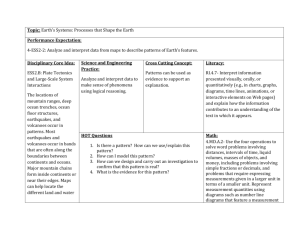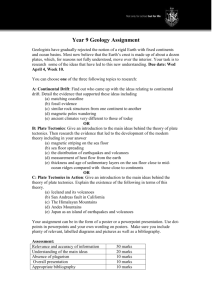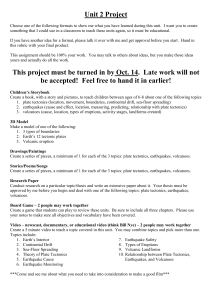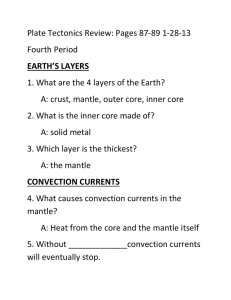TOPIC WORD DEFINITION Volcanoes aftershock An earthquake
advertisement
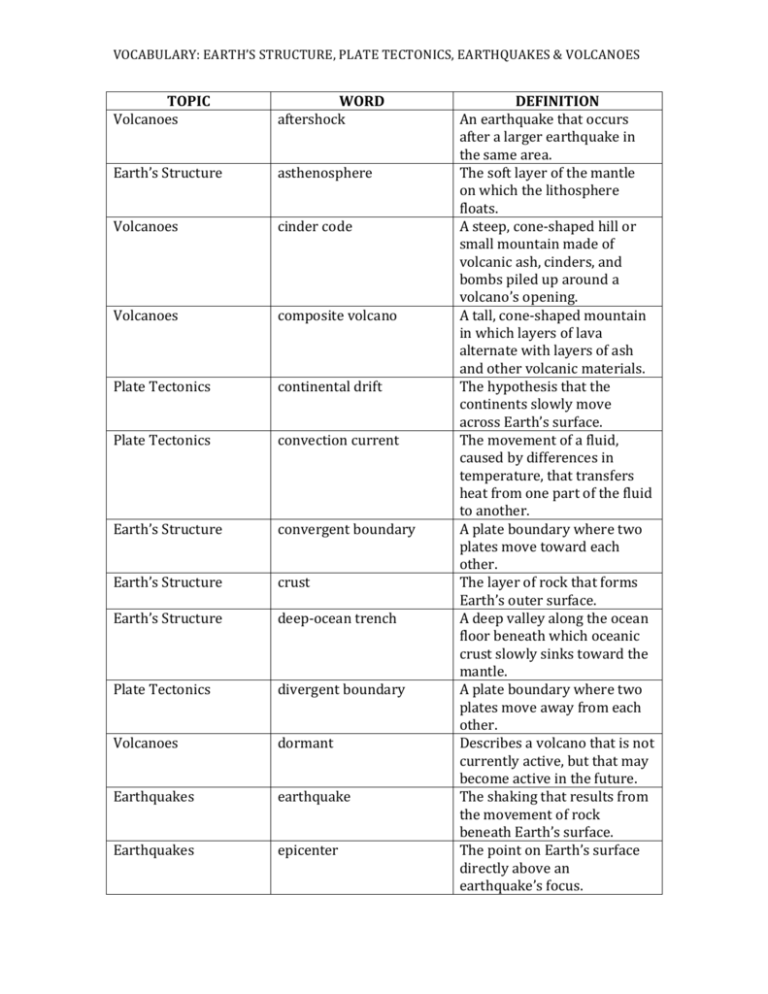
VOCABULARY: EARTH’S STRUCTURE, PLATE TECTONICS, EARTHQUAKES & VOLCANOES TOPIC Volcanoes WORD aftershock Earth’s Structure asthenosphere Volcanoes cinder code Volcanoes composite volcano Plate Tectonics continental drift Plate Tectonics convection current Earth’s Structure convergent boundary Earth’s Structure crust Earth’s Structure deep-­‐ocean trench Plate Tectonics divergent boundary Volcanoes dormant Earthquakes earthquake Earthquakes epicenter DEFINITION An earthquake that occurs after a larger earthquake in the same area. The soft layer of the mantle on which the lithosphere floats. A steep, cone-­‐shaped hill or small mountain made of volcanic ash, cinders, and bombs piled up around a volcano’s opening. A tall, cone-­‐shaped mountain in which layers of lava alternate with layers of ash and other volcanic materials. The hypothesis that the continents slowly move across Earth’s surface. The movement of a fluid, caused by differences in temperature, that transfers heat from one part of the fluid to another. A plate boundary where two plates move toward each other. The layer of rock that forms Earth’s outer surface. A deep valley along the ocean floor beneath which oceanic crust slowly sinks toward the mantle. A plate boundary where two plates move away from each other. Describes a volcano that is not currently active, but that may become active in the future. The shaking that results from the movement of rock beneath Earth’s surface. The point on Earth’s surface directly above an earthquake’s focus. VOCABULARY: EARTH’S STRUCTURE, PLATE TECTONICS, EARTHQUAKES & VOLCANOES Volcanoes fault Earthquakes focus Volcanoes geothermal activity Volcanoes geyser Volcanoes hot spot Earth’s Structure inner core Volcanoes island arc Volcanoes lava Volcanoes lava flow Earth’s Structure lithosphere Volcanoes magma Volcanoes magma chamber Earth’s Structure mantle Earthquakes Mercalli scale Plate Tectonics mid-­‐ocean ridge A break in the Earth’s crust where masses of rock slip past each other. The point beneath Earth’s surface where rock breaks under stress and causes an earthquake. The heating of underground water by magma. A fountain of water and steam that builds up pressure underground and erupts at regular intervals. An area where magma from deep within the mantle melts through the crust above it. A dense sphere of solid iron and nickel at the center of the Earth. A string of islands formed by the volcanoes along a deep-­‐ ocean trench. Liquid magma that reaches the surface; also the rock formed when liquid lava hardens. The area covered by lava as it pours out of a volcano’s vent A rigid layer made up of the uppermost part of the mantle and the crust. The molten mixture of rock-­‐ forming substances, gases, and water from the mantle. The pocket beneath a volcano where magma collects. The layer of the hot, solid material between Earth’s crust and core. A scale that rates earthquakes according to their intensity and how much damage they cause at a particular place. An undersea mountain chain where new ocean floor is VOCABULARY: EARTH’S STRUCTURE, PLATE TECTONICS, EARTHQUAKES & VOLCANOES Volcanoes moment magnitude scale Earth’s Structure outer-­‐core Plate Tectonics Pangaea Plate Tectonics plate Plate Tectonics plate tectonics Volcanoes pyroclastic flow Earthquakes Richter scale Plate Tectonics rift valley Volcanoes Ring of Fire Plate Tectonics sea-­‐floor spreading Volcanoes seismic waves Volcanoes seismogram produced; a divergent plate boundary. A scale that rates earthquakes by estimating the total energy released by an earthquake. A layer of molten iron and nickel that surrounds the inner core of Earth. The name of the single landmass that broke apart 200 million years ago and gave rise to today’s continents. A section of the lithosphere that slowly moves over the asthenosphere, carrying pieces of continental and oceanic crust. The theory that pieces of Earth’s lithosphere are in constant motion, driven by convection currents in the mantle. The expulsion of ash, cinders, bombs, and gases, during an explosive volcanic eruption. A scale that rates an earthquake’s magnitude based on the size of its seismic waves. A deep valley that forms where two plates move apart. A major belt of volcanoes that rims the Pacific Ocean The process by which molten material adds new oceanic crust to the ocean floor. Vibrations that travel through Earth carrying the energy released during an earthquake. The record of an earthquake’s seismic waves produced by a seismograph. VOCABULARY: EARTH’S STRUCTURE, PLATE TECTONICS, EARTHQUAKES & VOLCANOES Volcanoes seismograph Plate Tectonics shearing Volcanoes shield volcano Plate Tectonics sonar Plate Tectonics stress Plate Tectonics subduction Plate Tectonics tension Plate Tectonics transform boundary Earthquakes tsunami Volcanoes viscosity Volcanoes volcano A device that records ground movements caused by seismic waves as they move through Earth. Stress that pushes masses of rock in opposite directions, in a sideways movement. A wide, gently sloping mountain made of layers of lava and formed by quiet eruptions. A device that determines the distance of an object under water by recording echoes of sound waves. A force that acts on rock to change its shape or volume. The process by which oceanic crust sinks beneath a deep-­‐ ocean trench and back into the mantle at a convergent plate boundary. The stress that stretches rock so that it becomes thinner in the middle. A plate boundary where two plats move past each other in opposite directions. A large wave produced by an earthquake on the ocean floor The resistance of a liquid to flowing. A weak spot in the crust where magma has come to the surface.




